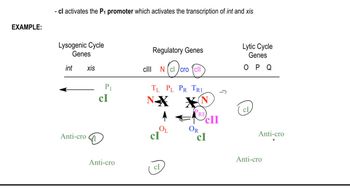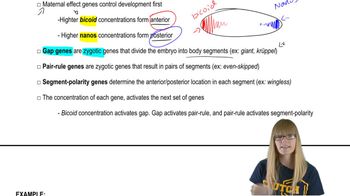Two different mutations affect PRE. Mutant 1 decreases transcription from the promoter to 10% of normal. Mutant 2 increases transcription from the promoter to 10 times greater than the wild type. How will each mutation affect the determination of the lytic or lysogenic life cycle in mutant λ phage strains? Explain your answers.
Table of contents
- 1. Introduction to Genetics51m
- 2. Mendel's Laws of Inheritance3h 37m
- 3. Extensions to Mendelian Inheritance2h 41m
- 4. Genetic Mapping and Linkage2h 28m
- 5. Genetics of Bacteria and Viruses1h 21m
- 6. Chromosomal Variation1h 48m
- 7. DNA and Chromosome Structure56m
- 8. DNA Replication1h 10m
- 9. Mitosis and Meiosis1h 34m
- 10. Transcription1h 0m
- 11. Translation58m
- 12. Gene Regulation in Prokaryotes1h 19m
- 13. Gene Regulation in Eukaryotes44m
- 14. Genetic Control of Development44m
- 15. Genomes and Genomics1h 50m
- 16. Transposable Elements47m
- 17. Mutation, Repair, and Recombination1h 6m
- 18. Molecular Genetic Tools19m
- 19. Cancer Genetics29m
- 20. Quantitative Genetics1h 26m
- 21. Population Genetics50m
- 22. Evolutionary Genetics29m
12. Gene Regulation in Prokaryotes
Lambda Bacteriophage and Life Cycle Regulation
Problem 28c
Textbook Question
How would mutations that inactivate each of the following genes affect the determination of the lytic or lysogenic life cycle in mutated λ phage strains? Explain your answers.
cro
 Verified step by step guidance
Verified step by step guidance1
Understand the role of the cro gene: The cro gene in λ phage encodes the Cro protein, which is a key regulator in determining whether the phage enters the lytic or lysogenic cycle. Cro protein represses the expression of the cI gene, which encodes the λ repressor protein. The λ repressor promotes the lysogenic cycle by repressing lytic genes.
Analyze the effect of inactivating cro: If the cro gene is inactivated, the Cro protein will not be produced. Without Cro, the cI gene will not be repressed, leading to increased production of the λ repressor protein.
Predict the impact on the life cycle: With higher levels of the λ repressor protein, the phage is more likely to enter or remain in the lysogenic cycle, as the λ repressor actively suppresses the expression of genes required for the lytic cycle.
Consider the balance of regulatory proteins: Normally, the decision between the lytic and lysogenic cycles depends on the balance between Cro and the λ repressor. In the absence of Cro, this balance is disrupted, favoring the lysogenic cycle.
Summarize the outcome: Mutations that inactivate the cro gene would likely result in a bias toward the lysogenic life cycle, as the repression of the cI gene by Cro is a critical step in promoting the lytic cycle.
 Verified video answer for a similar problem:
Verified video answer for a similar problem:This video solution was recommended by our tutors as helpful for the problem above
Video duration:
3mPlay a video:
Was this helpful?
Key Concepts
Here are the essential concepts you must grasp in order to answer the question correctly.
Lytic and Lysogenic Cycles
The lytic and lysogenic cycles are two distinct pathways that bacteriophages, like λ phage, can follow after infecting a bacterial host. In the lytic cycle, the phage replicates rapidly, leading to the destruction of the host cell and the release of new phage particles. In contrast, the lysogenic cycle involves the integration of the phage DNA into the host genome, allowing it to replicate along with the host cell without causing immediate harm.
Recommended video:
Guided course

Decision Between Lytic and Lysogenic Cycles
Role of the cro Gene
The cro gene in λ phage is crucial for regulating the switch between the lytic and lysogenic cycles. It encodes a protein that promotes the lytic cycle by inhibiting the expression of genes necessary for lysogeny, such as cI, which encodes the repressor protein. When cro is active, it favors the production of new phage particles, while its inactivation can lead to a preference for the lysogenic pathway.
Recommended video:
Guided course

Segmentation Genes
Mutations and Gene Function
Mutations are changes in the DNA sequence that can affect gene function. In the context of the cro gene, mutations that inactivate it would prevent the production of the cro protein, disrupting the balance between the lytic and lysogenic cycles. This could lead to an increased likelihood of lysogeny, as the repression of lysogenic genes would be lifted, allowing the phage to integrate its DNA into the host genome instead of immediately replicating.
Recommended video:
Guided course

Functional Genomics

 4:29m
4:29mWatch next
Master Bacteriophage Life Cycle with a bite sized video explanation from Kylia
Start learningRelated Videos
Related Practice
Textbook Question
305
views
